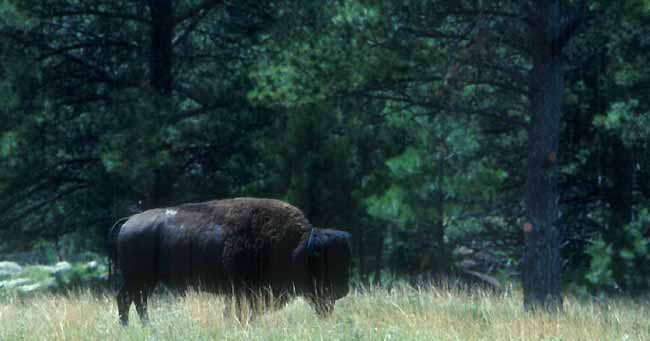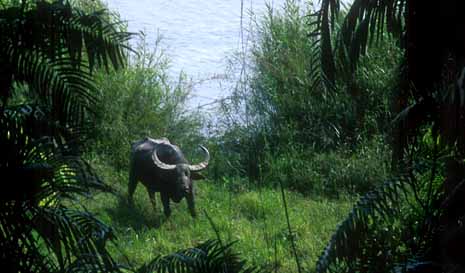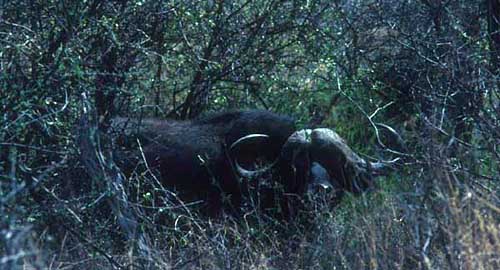
 There
are 12 species of Wild Cattle (tribe Bovini)
in the world but several have either been entirely domesticated or else
hunted to extinction. Domestic cows Bos primigenius exist in the
billions but their wild ancestors died out by 1627. The American Bison
Bison
bison (right and below) once roamed in numberless herds
across the Great Plains of North America but now exist is fragmented small
groups that range through some National Parks or private reserves. [Actually,
the estimate is 40-60 million before the arrival of Europeans.] Although
often considered the classic mammal of the open prairie it also is at home
in broken woodlands (below). Its close relative the European Bison Bison
bonasus became extinct in the wild about 1919. The Yak Bos mutus
of alpine tundra and ice deserts of the Tibetan Plateau has also been domesticated
but there are a few wild herds. [The Musk Ox Ovibos moschatus is
not a wild cow but is more closely related to sheep and goats in subfamily
Caprinae.]
There
are 12 species of Wild Cattle (tribe Bovini)
in the world but several have either been entirely domesticated or else
hunted to extinction. Domestic cows Bos primigenius exist in the
billions but their wild ancestors died out by 1627. The American Bison
Bison
bison (right and below) once roamed in numberless herds
across the Great Plains of North America but now exist is fragmented small
groups that range through some National Parks or private reserves. [Actually,
the estimate is 40-60 million before the arrival of Europeans.] Although
often considered the classic mammal of the open prairie it also is at home
in broken woodlands (below). Its close relative the European Bison Bison
bonasus became extinct in the wild about 1919. The Yak Bos mutus
of alpine tundra and ice deserts of the Tibetan Plateau has also been domesticated
but there are a few wild herds. [The Musk Ox Ovibos moschatus is
not a wild cow but is more closely related to sheep and goats in subfamily
Caprinae.]
 Wild
Water Buffalo Bubalus arnee (right) are also isolated
in fragmented small populations in Asia although millions of domesticated
working beasts are common throughout the Orient. I have seen small numbers
of wild buffalo near the extremes of their range. In Kaziranga Park, Assam,
India they live in marshy swamps (right) but in Baluran Park, eastern tip
of Java, Indonesia they occur in dry thornscrub and come to waterholes
at dawn or dusk. In the wild they are unpredictable and dangerous.
Wild
Water Buffalo Bubalus arnee (right) are also isolated
in fragmented small populations in Asia although millions of domesticated
working beasts are common throughout the Orient. I have seen small numbers
of wild buffalo near the extremes of their range. In Kaziranga Park, Assam,
India they live in marshy swamps (right) but in Baluran Park, eastern tip
of Java, Indonesia they occur in dry thornscrub and come to waterholes
at dawn or dusk. In the wild they are unpredictable and dangerous.
There are six other wild cows in tropical Asia; I've seen but one: a single Banteng Bos javanicus crossed the road early in the day at Baluran Park in eastern Java, and has rather the look of a feral cow. It is found only in protected forests there and on Borneo. The Gaur Bos gaurus exists only locally in forest glades for Asia from India to Malaysia. Exceedingly endangered are two anoas on Sulawesi (Lowland Anoa Bubalus depressicornis and Mountain Anoa B. quarlesi) and the Tamarau B. mindorensis on Mindoro in the Philippines. Finally, the near mythical Kouprey Bos sauveli has been rediscovered recently in Vietnam and Cambodia.
 The African Buffalo Synceros caffer (left) is still
common in the wild parts of sub-Saharan Africa. It the days of yore a century
ago when hunting safaris were the rage, this was considered the most dangerous
of the "big five" in the continent because of its unpredictable and aggressive
nature. All my encounters are within parks and game reserves but we always
steer them a wide course.
The African Buffalo Synceros caffer (left) is still
common in the wild parts of sub-Saharan Africa. It the days of yore a century
ago when hunting safaris were the rage, this was considered the most dangerous
of the "big five" in the continent because of its unpredictable and aggressive
nature. All my encounters are within parks and game reserves but we always
steer them a wide course.
 There
are two subspecies of African Buffalo: the Cape Buffalo
S.
c. caffer (above) and the Forest Buffalo S. c. nanus
(right in a distant view). The latter is much smaller and lives
in the dense forests of the Congo Basin. The large males are often reddish
in color, and all are much more secretive that the Cape Buffalo.
There
are two subspecies of African Buffalo: the Cape Buffalo
S.
c. caffer (above) and the Forest Buffalo S. c. nanus
(right in a distant view). The latter is much smaller and lives
in the dense forests of the Congo Basin. The large males are often reddish
in color, and all are much more secretive that the Cape Buffalo.
The widespread Cape Buffalo live in large herds; in the Serengeti plains
they average 350 per herd. An alarm call brings the entire herd to the
defense of a frightened animal. Like Water Buffalo, the African Buffalo
is usually near water (such as the sluggish rivers across the savanna)
but is often located in dense thickets or tall grass. One must be very
careful when entering scrubby thickets when in the range of African Buffalo.
The taxonomy here follows Macdonald, D., ed. (1984) The Encyclopedia of Mammals. 1st ed. Facts on File Publ., New York. Other than personal experiences, the facts are also summarized from that text.
PHOTOS: All photos on this page are © 2001 Don Roberson; all rights reserved. The American Bison was in Wind Cave National Park, South Dakota, on 16 June 1998. The Wild Water Buffalo was in Kaziranga National Park, Assam, India, in April 2001. The Cape Buffalo was in Kruger National Park, South Africa, and the Forest Buffalo were in La Lopé Reserve, Gabon, both in July 1996.